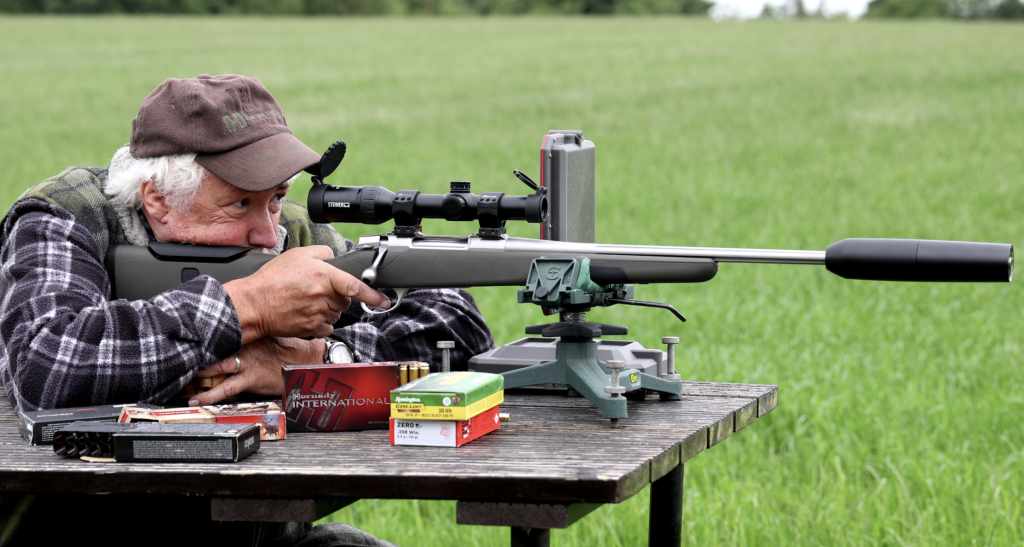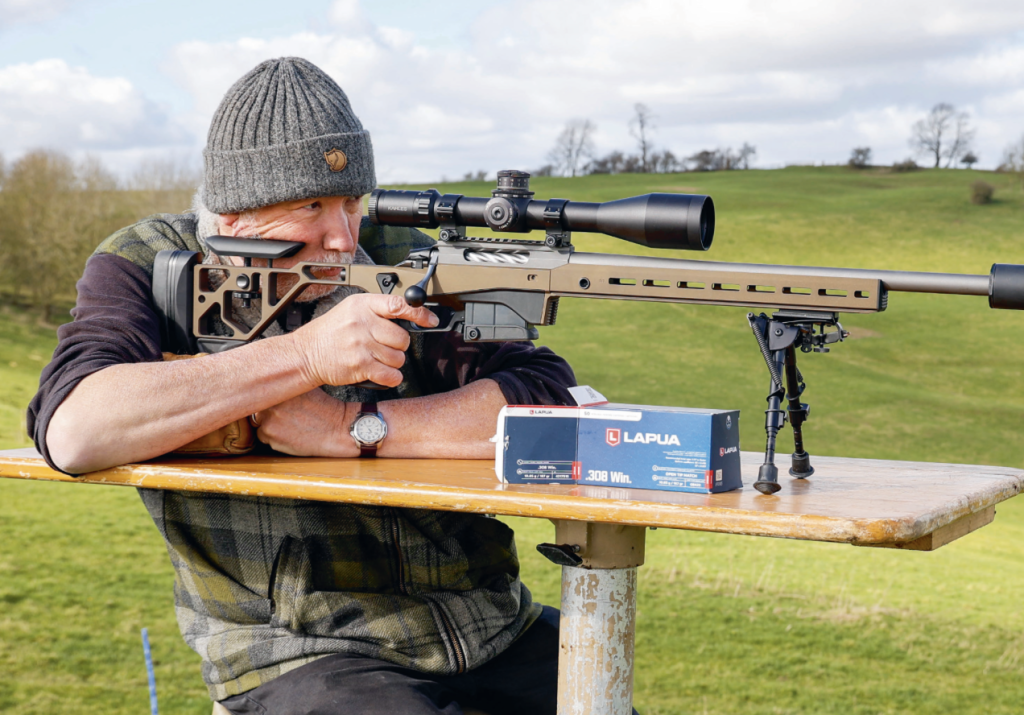Nosler Model 21 in .308 Winchester
Chris Parkin takes a close look at an American import that screams US of A! A rifle that could offer the ideal hunting platform for smaller shooters
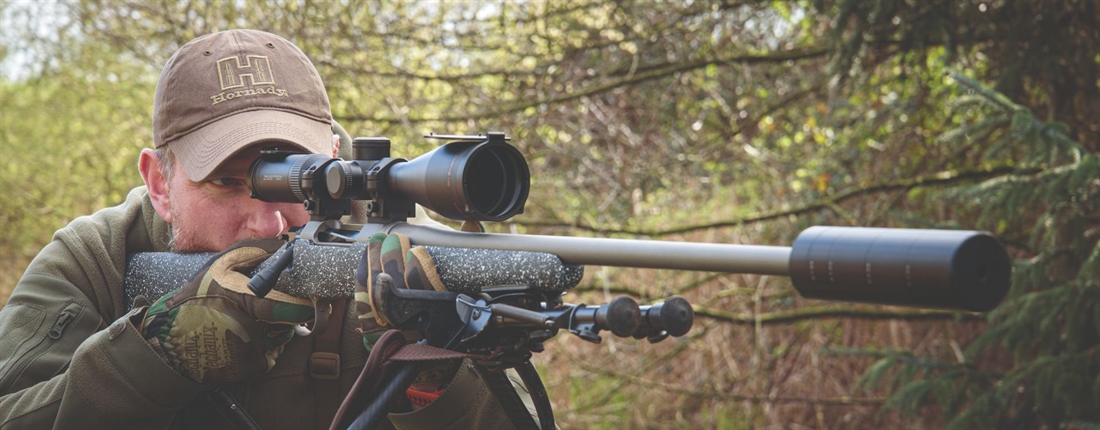
The new Model 21 rifle from Nosler and carries all the design hallmarks of an American classic that employs many of the ergonomic and mechanical elements commonly found in rifles inspired bythe US hunting culture.
The 21 is a lightweight rifle available in a variety of common calibres, as well as a few more unusual offerings. The review rifle was in easily fed .308 but you can have as small as 6.5 Creedmoor or up to .375 Holland & Holland with various boutique Nosler and Ackley calibres in between.
There is a .300 Win Mag, but I was surprised to see no .30-06, which is perhaps ‘the classic’ American cartridge? The Stainless Shilen Match grade barrel is 560mm or 22” in what’s known as a #3 contour with a 19mm muzzle diameter, tapering straight out to 21mm at the start of the chamber reinforce before it swells to the action.
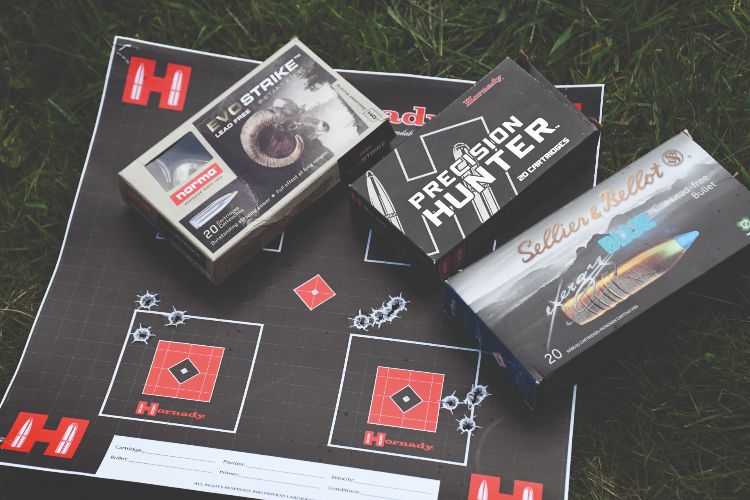
Nosler screwcut the rifle 5/8”x24 with a knurled thread protector for a moderator or muzzle brake and the 11-degree crown is neatly presented. The action is all Remington 700 (dimensionally) but that’s where any comparison ends. There is a selfindexing recoil lug sandwiched between barrel tenon and the action, which is seen here in ‘short’ format, with a 104mm bolt stroke for cartridges like the .308 and 6.5 Creedmoor. The long action covers all the larger chamberings. Short actions offer a 4-shot magazine with 3 rounds for the longs.
Although the rifle has rather classic lines there is nothing old-school about the manufacturing process. The action is wire EDM cut, which essentially means that an electric discharge (at extremely high voltage) cuts tiny amounts of extremely hard, conductive materials to precision tolerances.
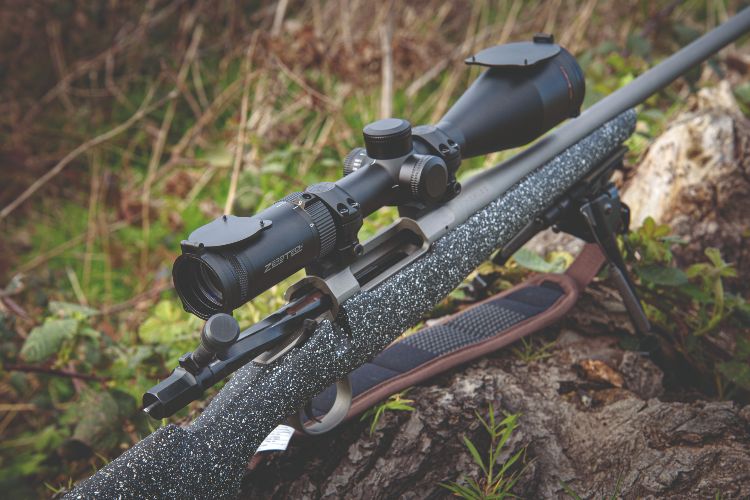
It is very expensive and as usual, computer controlled, but whereas conventional rotating cutters (no matter how hard), won’t machine extremely hard materials, EMD will. It also means materials can be cut after heat treatment rather than before, where heat treatment can lead to dimensional changes. It sounds very advanced; but does it make more accurate and consistent rifles?
Delving further into the action the bolt is a two-lug push-feed unit cut from a single piece of 4340 Chrome Molybdenum steel. This has an intentionally dissimilar deep blue/ black Nitride coating compared to the Cerakoted receiver to ensure long life and smooth transit.
It’s also hexagonally fluted to offer less bearing surface in contact with the receiver without any loss of stability. “Push feed” implies a recessed bolt face with a long M16- style extractor claw to draw the cases from the chamber. These are automatically ejected with a sprung plunger on the left side of the bolt face (from the shooter’s perspective) which throws cases clear of the rifle regardless of bolt speed.
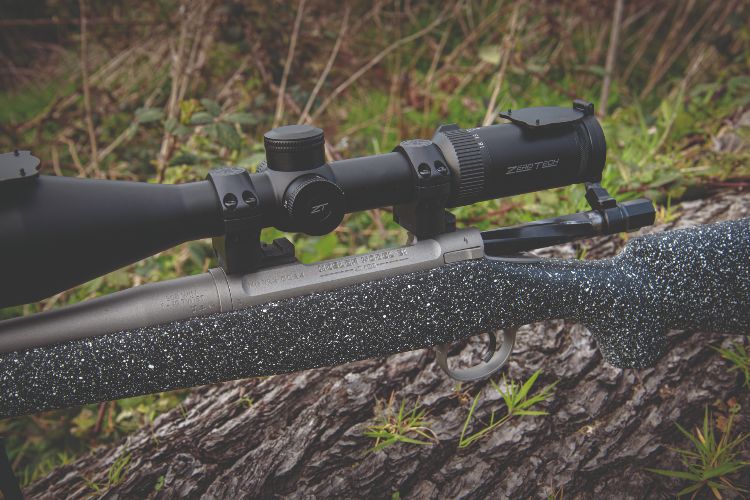
A 18mm teardrop caps the 60mm bolt handle that rises through 90-degrees to unlock the action and cock the firing pin. The teardrop handle is threaded in position and can be replaced if another shape is desired. There’s a bright stainless steel cocked action indicator that stands 7mm proud of the bolt’s shroud which also carries 5 flat facets to its overall circular shape.
Nosler supply Weaver bases that screw to the action bridges for scope mounting, which makes life easy and secure. The action itself is cylindrical with facets either side to create a more custom look, allowing for a flat engraving surface for the maker’s name whilst saving a fractional amount of weight.
Final controls are the left-side bolt release catch and two-position safety on the right side with forward for fire and rear for safe without bolt locking. Cartridges are loaded into a BDL-style sprung floorplate and fed smoothly to the chamber without any problems. You can empty the magazine with a release catch within the trigger guard that dumps the contents into your waiting palm and, of course, because it’s loaded though the top/ejection port, you can add more at any time.
A TriggerTech unit is fitted for the obvious purpose. It’s a single stage trigger and adjustable from 2.5 to 5 lb (1,100-2,200g) via a single Allen screw accessible upward within the trigger guard. As usual, this manufacturer supplies an excellent trigger with great feel on the shallow curved 7mm-wide blacked blade which features delicate serration for a consistent, crisp break.
They call it their Frictionless Release Technology as a marketing term, but regardless, it’s a great trigger with predictable and consistent release from shot to shot, without any negative attributes. This example arrived from the factory at 1,670g which seems appropriate for a hunting rifle. There is a slight design departure here: a trigger hanger is used so it’s not pinned directly to the action like on a Remington.
Nosler’s goal of a lightweight hunting rifle with no sacrifice in accuracy is most clearly focused with the McMillan Hunter’s Edge carbon stock. This is the critical ergonomic bridge between human and mechanics, providing the best weight-saving opportunities.
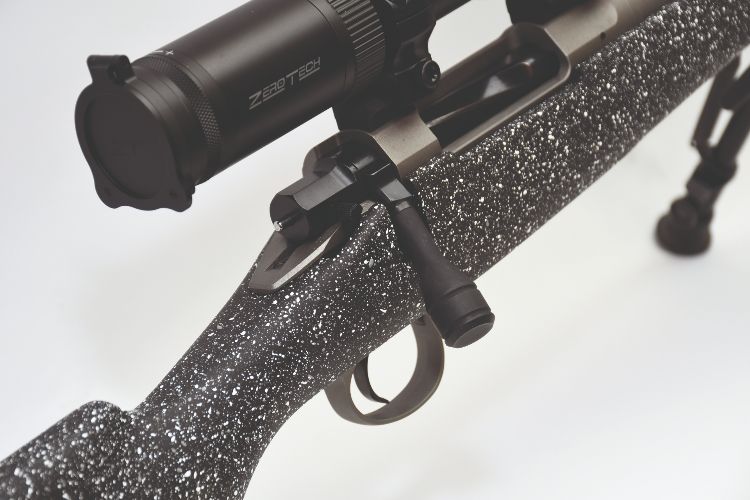
The stock is a light sporter profile with a stiff forend that’s just 31.5mm wide. This is excellent though, as the barrel channel offers a parallel 1mm gap for the barrel to free float within and the carbon structure which enables this slim forend to remain very stiff with no intermittent contact that would cause inconsistency.
There is a stud on the underside for sling or bipod and there are no issues with any worrisome flex, which would appear as a wobbly aim or random change in zero.
Coarse stippling is present throughout the stock for easy grip in any weather and this complements the speckled black and white finish. The action is held into the stock with twin 5/32” Allen screws spanning the magazine floorplate, which itself incorporates the folded spring steel mechanism to lift the rounds to the feed ramp.
Keep these leaf springs wiped over regularly with an oily cloth because, although hidden, they have a very light blued coating and will rust easily. The open radius grip is almost straight handed with no palm swell or specific hold position, it flows into the butt with a straight comb above that’s parallel to the bore line, 7mm below the bolt’s exposed firing pin sear.
Length of pull is 343mm/13.5” including the 23mm thick Decelerator recoil pad, which is not at all spongy, although it has a ‘hollow’ about a third of the way down from heel to toe to enable compression.
Removing the barrelled action from the stock shows a small amount of the recoil pad is bonded in position, so adding spacers is not straightforward. Short length of pull seems to go hand in hand with non-adjustable stocks from the US and I find it makes me feel that I overwhelm the gun somewhat, especially when coupled with a small grip and a long eye relief scope. It’s all about the size of gun you need but it feels a little too small for me. It is after all designed to be a lightweight rifle and the easiest way to save weight is to make things physically smaller. Highland Outdoors sent a ZeroTech Thrive 3-18X56 HD riflescope, bedding compound in the base of the recoil lug pocket but not under the action or surrounding the lug itself. The stock is advertised to have pillars within it, but these are not visible underneath the ‘all weather’ epoxy coating that seamlessly covers the stock’s action inlet, as well as its external surfaces.
This will of course prevent any moisture ingress at all, even though the carbon/epoxy is impervious to corrosion. However, it’s a nice feature that seals any voids that could accumulate moisture.
Length of pull is rather short, and the recoil pad is bonded in position, so adding spacers is not straightforward. Short length of pull seems to go hand in hand with non-adjustable stocks from the US and I find it makes me feel that I overwhelm the gun somewhat, especially when coupled with a small grip and a long eye relief scope. It’s all about the size of gun you need but it feels a little too small for me. It is after all designed to be a lightweight rifle and the easiest way to save weight is to make things physically smaller.
Highland Outdoors sent a ZeroTech Thrive 3-18X56 HD riflescope, Tier-One scope rings and an RCC moderator for use with the rifle. The rifle was brand-new and the bore cleaned easily with no remnants of copper from proof firing at all.
Bolt out and bore sighted, it was simple to zero and I ran it in with intermittent cleaning for 25 rounds before commencing group testing. I used a selection of ammunition, all shot at 100m. There were ups and downs while looking for the best match which was finally found with Sellier and Bellot Blue, Lead-free ammunition which presented the smallest 3 shot group.
I then extended to four rounds just to be sure. The last round remained within the 21mm centre to centre group spanned by the first three shots.
The barrel has a 1 in 10” twist, and regardless of actual bullet mass the lower density, and hence longer copper bullets (of just 110gr), were ideally stabilised with consistent velocity.
Muzzle energy was still comfortably legal, yet as always the heavier bullets seem to get the best energy out of a .308 and 175gr Hornady Precision Hunter were as always a good performer with sub-MOA groups. The extra 670 ft/lbs of muzzle energy provided would be appreciated if tackling larger deer or heavier game.
 ERGONOMICS
ERGONOMICS
This is one of those rifles that pits the engineers against the shooter, and I must admit feeling I didn’t get the best from this gun as it was small for my stature, and I had to crane my head back from the scope to allow my shoulder to make full contact with the stock while maintaining correct eye relief.
One of the core rules of shooting is to remain in a relaxed comfort position wherever possible and although I didn’t necessarily have a problem shooting it, I wonder if I would have done better with a more comfortable position when aiming.
Things were different when shooting from an improvised rest, high seat or from quad sticks as the shorter length of pull was less of a factor when combined with a more vertical head/ body position.
The stock’s texture is incredibly grippy like fine sandpaper, and although small, you can get a decent hold on the stock – but in the heavier calibres I suspect it would be very lively and need a very firm hold. The forend is slim so bear that in mind if you have big hands – the stock won’t touch the barrel, but you don’t want your fingers to either.
All the rifle’s mechanics work flawlessly and I found the barrel easy to clean without undue effort. The external finish is corrosion-resistant, and that fluted bolt will itself shrug off dust and debris as it operates, while the smooth Nitride finish wipes clean without any effort.
I like the hexagonal shape and it has definite ergonomic benefits with the light bolt operation never jamming even when cycled quickly. The hexagonal profile is a neat idea because it maintains quite close tolerances with minimal contact between the two components.
The trigger is faultless and because I have used them on quite a few rifles I have no long-term doubts about TriggerTech at all. It’s a great unit!
Other handling traits include the slightly forward weight bias (without moderator) which obviously arises due to the light carbon stock and a relatively heavy barrel. This helps keep the gun pointable and lessens muzzle lift slightly.
Recoil is handled modestly, and I thought the recoil pad itself was ideally specified for grip into the shoulder and the physical force transfer; it is an individually branded component through Pachmayr ‘Decelerators’ who have earned their name.
The inherent grip of the stock’s surface makes it easy to handle when weaving around foliage and it’s also quiet with no hollow resonance from the stock through recoil or in contact with mother nature’s obstacles.
CONCLUSION
Nosler advertise that: “The Model 21 is built by riflemen, for riflemen and provides exceptional reliability and packable precision to any hunt –wherever that may be.” I can’t disagree with this statement, as only individual hunters and shooters can decide and dictate what they need from a rifle.
All I can do is highlight its characteristics relative to its peers and broaden the finer points listed in the spec sheets. I’d be very keen to try these precision mechanics in a different stock in a future review. The company make other rifles, including the Hunter Carbon Chassis, which offer length of pull adjustment with spacers.
For the traditionalists, the similar Model 48 rifles (also 13.5” length) are available, but they are all Remington 700 footprints, so you could theoretically have the Nosler 21 action in any Remington 700 compatible stock, of which many are available.
The Nosler name without doubt ensures superb mechanics and I liked the technical approach to materials and subtle design elements, In the end it’s an unusual rifle, and you are unlikely to bump into anyone else with one, which in itself creates a certain exclusivity.
REMINGTON 700 COMPATIBILITY
This phrase is used quite frequently and in general terms it is a statement of the actual footprint of the action. This is the overall shape and dimensions of the receiver underside and screw spacing.
Secondary factors like the trigger fit and scope mount are also included. What is not identical is the tolerances and materials with which receivers and bolts are made, as well as key internal dimensions like the barrel tenon threads etc.
If a rifle is Rem 700 compatible, you will always find scope mounts, triggers, and stocks in long or short action dimensions. If you really want to aid precision though, get it bedded because the stock/action interface is critical to achieving the best from any rifle.
PRICES
■ Nosler Rifle 40721 Nosler M21 .308 Win £3249.99
■ ZeroTech Thrive 3-18X56 HD Rifle Scope £865.99
■ Tier One Picatinny Rings £145.99
■ RCC F48 Moderator, £240.99 (Thread Nut 5/8″ x 24 UNEF £8.99)
CONTACTS
RIFLE
■ Highland Outdoors www.highlandoutdoors.co.uk
AMMO
■ Hornady www.edgarbrothers.com
■ RWS www.ruag.co.uk
■ Sellier & Bellot www.vikingarms.com
Essential maintenance: Always air dry your rifle before returning it to the cabinet and always remove the mod!
TECH SPECS
- Calibre: .308 on review (medium action), 6.5 Creedmoor, 26/27/28/30 and 33 Nosler, .280 Ackley, .300 WinMag, .375 H&H
- Barrel length: 560mm/22”, 1 in 10” twist rate
- Overall length: 1057mm/41.5”
- Weight: 3022gg/6lbs 10 oz.
- Muzzle thread: 5/8”x24 TPI
- Stock: Carbon Fibre ambidextrous
- Length of pull: 343mm/13.5”
- Trigger: Single stage adjustable, 1670gr/56 oz adjustable (1100-2200gr/40-80 oz)
- Safety Catch: Two position without bolt lock
- Magazine: Floorplate magazine, 4+1 capacity
Related Articles
Get the latest news delivered direct to your door
Subscribe to Rifle Shooter
Elevate your shooting experience with a subscription to Rifle Shooter magazine, the UK’s premier publication for dedicated rifle enthusiasts.
Whether you’re a seasoned shot or new to the sport, Rifle Shooter delivers expert insights, in-depth gear reviews and invaluable techniques to enhance your skills. Each bi-monthly issue brings you the latest in deer stalking, foxing, long-range shooting, and international hunting adventures, all crafted by leading experts from Britain and around the world.
By subscribing, you’ll not only save on the retail price but also gain exclusive access to £2 million Public Liability Insurance, covering recreational and professional use of shotguns, rifles, and airguns.
Don’t miss out on the opportunity to join a community of passionate shooters and stay at the forefront of rifle technology and technique.



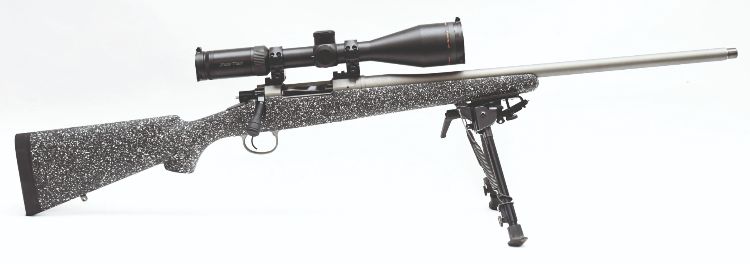 ERGONOMICS
ERGONOMICS